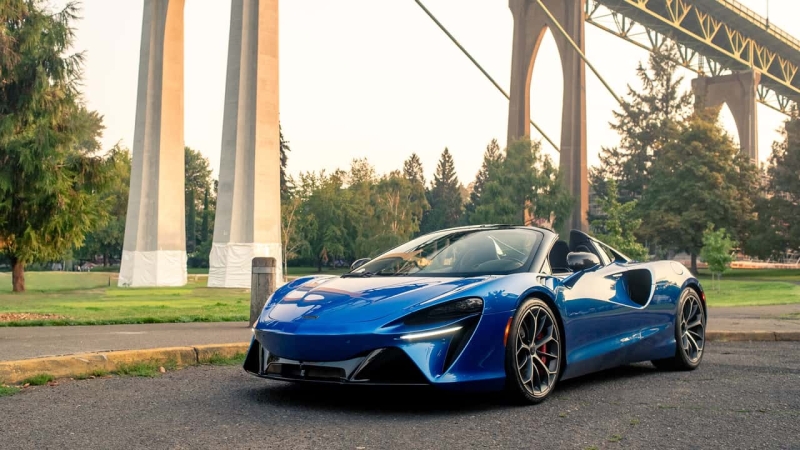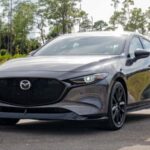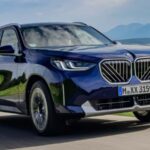McLaren occupies an odd spot in the supercar pantheon. I wanted to find out who these cars are for.
Victoria Scott / Motor1
No one can deny that the name McLaren is one of the most legendary in motorsports. The racing team has a cabinet bursting with trophies dating back fifty years. McLaren Automotive, the car manufacturer, has been harder to make heads or tails of. While a new Ferrari carries the weight of decades of tradition and the dreams of Enzo himself, a new McLaren is a very quick car from a company that isn’t old enough to have a beer.
While McLaren Automotive has enjoyed resounding success since the introduction of the MP4-12C in 2011, the company’s oh-so-brief lifespan means that every new model pops into existence without context or, truthfully, a sense of gravitas. Although the names have gotten easier to remember since that initial alphabet-soup model, the cars themselves have followed a similar formula: Dump a bunch of fresh tech into something ripped from a futuristic mecha anime. Proceed to sell them as fast as you can hand-build them.
This is a 2025 McLaren Artura Spider Hybrid. It’s the lightest convertible supercar on the market, its electric motor is even more power-dense than the McLaren P1’s, its transmission is 25% faster than last years’ model, and crucially, it follows the McLaren formula to the letter: swoopy, futuristic bodywork wrapped around a high-tech fast-as-hell drivetrain. Most importantly for me, this will be my hands-on introduction to McLaren, and it seems as good a place to start as any.
| Quick Specs | 2025 McLaren Artura Spider Hybrid |
| Engine | Twin-Turbocharged 3.0-Liter V-6 Hybrid |
| Output | 690 Horsepower / 531 Pound-Feet |
| Efficiency | 17 City / 21 Highway / 19 Combined |
| Base Price / As Tested | $278,800 / $344,718 |
| On-Sale Date | Now |
After all, the Artura’s aesthetic is definitely very McLaren. Barring the extraordinary and limited-production P1 and Senna models (officially known as part of the McLaren Ultimate Series), all of the company’s cars have resembled increasingly futuristic and angrier versions of the MP4-12C to the point of being difficult to distinguish. While the Artura has stylistic differences from the 570S it replaces, it would be hard to tell exactly what changed without looking at a side-by-side comparison. It certainly doesn’t seem newer or more futuristic. It just looks like another McLaren.
This isn’t necessarily a bad thing, although it undersells just how complete a rework the Artura is. Its carbon-fiber monocoque platform is all-new and specifically designed for hybrid drivetrains, and the Artura Spider is the first hybrid convertible McLaren has offered. The V-6 nestled behind the driver is the company’s first. It has all the modern supercar stats you could ask for: 690 horsepower and 531 pound-feet of torque, a 0-124 mph time of 8.4 seconds, and a top speed of 205.
Despite the electric top and hybrid drivetrain—which offers an EPA-rated 11 miles of electric range—it weighs just 3,439 pounds. Dry weight to dry weight, it’s 176 pounds lighter than a Ferrari 296 GTS.
It’s objectively impressive, which is why it’s a pity it looks rather the same as last year’s model. But even if the styling isn’t as timeless or as novel as other supercars, McLaren still sells every car they make, and they’re as popular as ever. The demand has to be more than skin deep.
While the McLaren-signature butterfly doors make getting situated in the cabin a little tricky, once inside, the Artura Spider is shockingly comfortable. The gauge pod moves with the wheel, so even adjusted for my lanky frame I could easily read the cluster. The footwell is small, but even in cowboy boots I still had enough pedal separation to easily manipulate gas and brake. The center touchscreen is easy enough to reach but still placed far enough out of line-of-sight that it doesn’t impede visibility.
Blissfully, there are no buttons on the steering wheel—all it does is steer the car, and it’s delightful. Toggling between driving modes and suspension settings is a physical affair—a pair of switches at the top edges of the cluster allow you to change on the fly without having to look at any screens or take your hands off the steering wheel. For a car that looks like the personal vehicle of a Gundam pilot, it’s shockingly analog inside. It suits a focus on the driving experience so well.
And what a driving experience it is. A calm, cool morning in Portland meant I had the top off before my seatbelt was even buckled. I immediately kicked the car from Electric to Sport mode, giving me the V-6’s gnarly tones directly behind my head—aided by the optional Sports Exhaust, which you must tick the box for on your build sheet. The soundtrack is genuinely excellent, and should handily disprove that sporty V-6s need to sound like straight-piped 350Zs.
A jaunt through Portland’s historic downtown proved that McLaren ride quality is worth the hype. I was driving on cobblestones and all of my fillings stayed in. Potholes and pavement gaps were easily handled without any rough impact or cabin reverberations that drop-tops are often prone to. None of this came at the expense of steering accuracy or sharpness, either. Pitching the Artura into a corner—even while still in Comfort—it was level, sharp, and perfectly correctable at speed.
I lined up at the red light for an on-ramp and gave the Artura full power to merge. It is breathtakingly fast; That electric motor delivers 166 pound-feet of torque at 0 mph and gives the McLaren an EV-like neck-whipping sense of acceleration. Sixty mph happened in three seconds flat; 60-[censored] arrived faster than I could keep track of as I slammed through gears on the eight-speed. There are other supercars that are a few tenths quicker, sure, but if the Artura isn’t fast enough for you, I would suggest seeking therapy to uncover what you’re really looking for out of life.
Once I’d calmed down from triple-digit testing, I settled in and watched the sunlight glittering off the glass towers of the skyline dance across the Alcantara dash. The interior just feels right for a driver’s car. If I got restless, I blipped a gear down, gave it gas, giggled, and relaxed again. Even at the speed limit, it was one of the most enjoyable drives I’ve had in a while.
This is remarkable, because usually when I get into a supercar I feel a need to push it to its limits (as much as I can comfortably find them, anyway) to feel like I’m fully appreciating it. I step out of supercars giddy, but sweaty and sore. The Artura Spider doesn’t need to be flogged to be appreciated. I had as much fun working it through some quick mountain twists as I did cruising on the highway, which is not something I’d expect in this class of car.
And after shooting these pics of the Artura Spider, on my route back I pumped up the Bowers & Wilkins system and jammed with the windows down on the streets of Portland. Regardless of whether or not the Artura is a perfect evolution of the company’s design language, people love how it looks. If you’re driving a supercar, you probably want attention, and this delivers. I got more stares and compliments with this bright-blue spaceship in an hour of driving than virtually anything else I’ve found myself behind the wheel of, ever.
Perhaps the secret to McLaren’s success, then, is that their cars don’t need a sense of heritage to sell themselves. If the Artura is any indication, a McLaren is simply fun, wicked fast, and easy to pilot at any speed. They look wild. They’re comfortable. I could actually see out of the cabin, even with the roof on. Want livability in a supercar? This one has a five-year powertrain warranty, for God’s sake.
Gravitas be damned. I’m here to drive, and the Artura Spider is one fantastic car to drive.
Competitors
- Ferrari 296 GTS
- Maserati MC20
- Lamborghini Huracan
Get the best news, reviews, columns, and more delivered straight to your inbox, daily. Sign up For more information, read our
Privacy Policy and Terms of Use.
2025 McLaren Artura Spider Hybrid
Engine Twin-Turbocharged 3.0-Liter V-6 Hybrid
Output 690 Horsepower / 531 Pound-Feet
Transmission Eight-Speed Dual Clutch
Drive Type Rear-Wheel Drive
Speed 0-60 MPH 3.0 Seconds
Maximum speed 205 Miles Per Hour
Weight 3,439 Pounds
Efficiency 17 City / 21 Highway / 19 Combined
EV Range 11 Miles (EPA) / 21 Miles (McLaren)
Seating Capacity 2
Base Price $278,800
As-Tested Price $344,718



